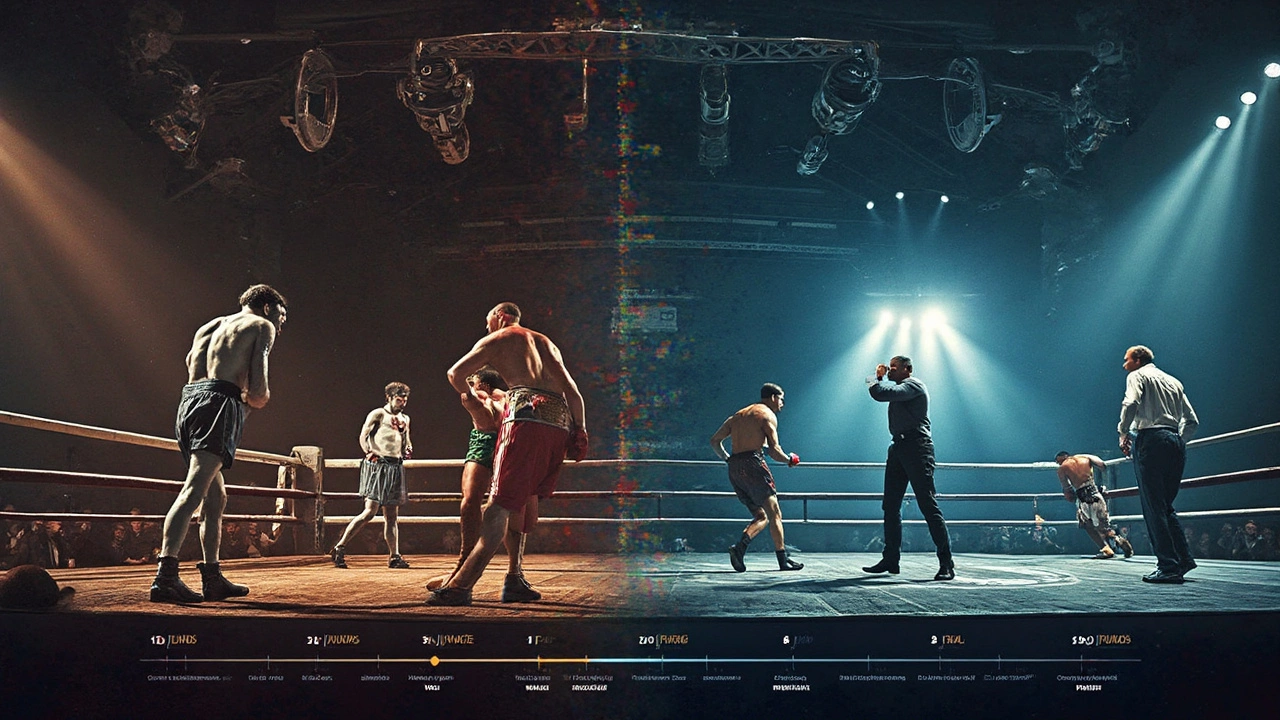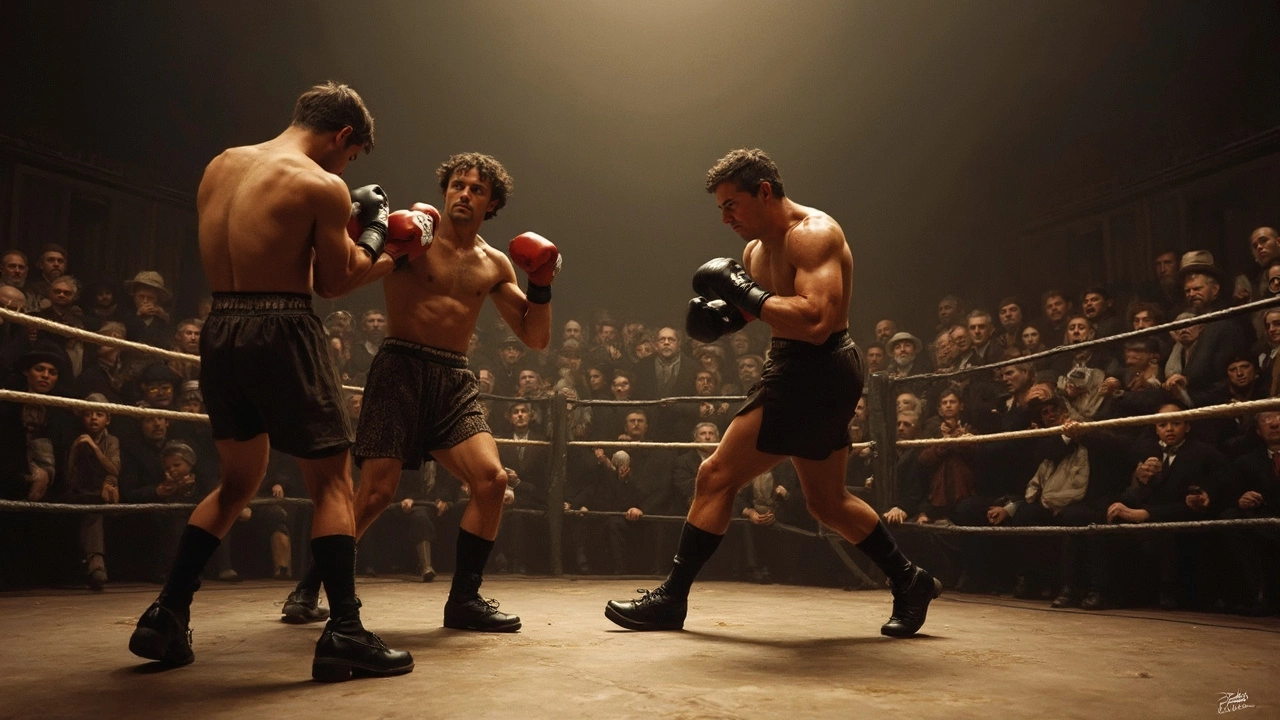Ever watched a boxing match and wondered why they last so long—or sometimes so short? It's all about the rounds. Boxing isn't just about throwing punches; it’s a strategic sport where knowing the structure of rounds can really make a difference.
Let's start with the basics. In most professional boxing matches, you're looking at up to 12 rounds, each lasting three minutes with a one-minute break in between. However, this wasn't always the case. Back in the day, matches went on until someone couldn't continue, which could mean dozens of rounds!
On the other hand, amateur boxing matches typically consist of 3 to 4 rounds, 3 minutes each for men, and slightly shorter for women. The shorter length in amateur fights is designed more for skill display than endurance, compared to the test of stamina and strategic pacing in longer professional matches.
- The Basics of Boxing Rounds
- Differences Between Amateur and Professional Matches
- How Round Length Influences Strategy
- Historic Changes in Round Structure
- Interesting Facts and Tips
The Basics of Boxing Rounds
So, you're curious about the structure of a boxing match? Let's break it down. Generally, the number of rounds in a boxing match depends on whether it's a professional or amateur bout. And each category has its set of standards.
For professional boxing, you'll typically find matches that are set for up to 12 rounds. Each round lasts three minutes, with a one-minute rest in between. This format is pretty much the norm these days, having been standardized by the major boxing organizations around the globe. However, championship and title fights are always 12 rounds, aiming to truly test the endurance and strategy of the boxers.
Amateur boxing, often seen in Olympic-style events, is shorter and sharper. Men's amateur matches usually last 3 rounds of three minutes each, while women’s matches might be slightly shorter with 2-minute rounds. The shorter rounds in amateur boxing mean fighters focus more on scoring points and displaying technical skills rather than just endurance.
Different Match Types
Here's the deal—it's not just about the length. Different fights have different rules regarding the number of rounds:
- Title Fights: These are 12 rounds—as demanding as it gets in professional boxing.
- Non-Title Fights: These can be anywhere from 4 to 10 rounds, depending on the agreement between the fighters and promoters.
- Exhibition Matches: Often shorter, these aren't scored or judged like typical competitive bouts.
A Quick Look at Round Lengths
Ever wondered if the round length has always been the same? Nope. The shift to the current standard came after concerns over safety and the need to keep the sport entertaining yet rigorous. Before this, matches could go on indefinitely until a fighter was knocked out, which was potentially too dangerous.
| Type of Match | Rounds | Duration |
|---|---|---|
| Professional Title Fight | 12 | 3 minutes each |
| Professional Non-Title Fight | 4-10 | 3 minutes each |
| Amateur Men's Match | 3-4 | 3 minutes each |
| Amateur Women's Match | 3-4 | 2 minutes each |
So essentially, understanding boxing rounds is all about context. Whether you're rooting for an amateur up-and-comer or a seasoned pro, knowing the number of rounds can deepen your appreciation for the fight's pacing and strategy.
Differences Between Amateur and Professional Matches
When it comes to boxing matches, the structure and rules can differ noticeably between amateur and professional levels. These differences aren't just technical—they profoundly influence how the game is played.
Round Structure and Duration
In terms of boxing rounds, amateurs usually compete in 3 to 4 rounds. Each round is generally 3 minutes for men, while women often compete in slightly shorter 2-minute rounds. The focus here is on speed, agility, and technique rather than endurance.
Professional matches are usually more demanding, going up to 12 rounds. Each round clocks at 3 minutes with a minute’s rest in between. This longer format tests a fighter's stamina and long-term strategy.
Scoring Systems
Amateur boxing prioritizes point scoring based on the number of clean hits landed, focusing on demonstrating skills and technique. International competitions often use a computer scoring system monitored by five judges. It's more like a sprint—a concentration on quick but effective punches.
On the flip side, professional boxing employs a more subjective 10-point system, where judges consider factors like knockdowns, dominance, and aggression. It's like a marathon, demanding strategic pacing across multiple rounds.
Gear and Safety
Amateur boxers don protective gear such as headguards, especially at the youth and beginner levels. This helps minimize potential injuries, allowing athletes to focus on honing skills without the risk of severe injuries.
Professional boxing is a different ball game—it’s headgear-free, emphasizing resilience and mental toughness. The intensity is higher, with more room for powerful punches, making every round pivotal.
Tables of Key Differences
| Aspect | Amateur | Professional |
|---|---|---|
| Rounds | 3-4 | Up to 12 |
| Round Duration | 2-3 minutes | 3 minutes |
| Scoring | Point System | 10-point System |
| Gear | Protective | No headgear |
Both levels have their unique charm—amateurs shine with speed and skill, whereas professional boxing matches captivate with endurance and strategic play. Whether you're a casual fan or hardcore boxing enthusiast, understanding these differences is key to truly appreciating the sport.

How Round Length Influences Strategy
When it comes to boxing, the length of rounds can seriously change the way fighters plan their matches. Imagine being a boxer—knowing exactly how long you've got to knockout your opponent or rack up points can shape every move and decision inside the ring.
Endurance vs. Sprint
If you're in a professional boxing match with 12 rounds, you're looking at a marathon, not a sprint. Fighters typically conserve their energy, looking to gradually wear down their opponent. It becomes a mental game of stamina, planning when to throw heavier punches, and when to hang back for a breather.
Amateur bouts are like sprints, short and intense. With only 3 or 4 rounds to dance around, boxers tend to come out swinging right from the start. It's all about immediate impact and grabbing the judges' attention with quick, effective combinations.
Adjusting Tactics
The round length also affects how trainers prepare their fighters. In longer bouts, coaches place greater emphasis on defense and technical skills, while shorter matches might focus more on aggressive tactics to secure early points or a quick victory.
Some interesting stats show that knockouts occur more often early in bouts when fighters still have their strength. For instance, in matches lasting 3 rounds or less, about 60% of KOs happen in the first two rounds.
Strategic Resilience
For boxers, adapting to different round lengths means tailoring everything from diet to training regimes. Longer matches mean bulking up that cardiovascular endurance, while shorter ones demand explosive power and speed. Also, psychological strategies differ. Longer matches require staying mentally focused over time, while shorter ones need quick thinking and immediate adaptability.
In summary, how many rounds in a boxing match aren't just numbers; they dictate the entire strategy a fighter needs to succeed. Whether it's pacing a 12-round professional duel or going all out in a 4-round amateur fight, understanding this aspect can transform the approach and outcome of any bout.
Historic Changes in Round Structure
Boxing has seen some wild changes over the years, especially when it comes to how boxing rounds are structured. Originally, matches didn't have round limits. Yup, fighters would just go at it until one couldn’t continue. Can you imagine the endurance and stamina needed for those fights?
In the late 19th century, the introduction of the Marquess of Queensberry Rules brought some sanity to the chaos. These rules, which came about in 1867, included the concept of three-minute rounds with a one-minute rest in between. It was a game-changer, making boxing more about strategy than sheer brawn.
Evolution in Professional Rounds
Fast forward to the 20th century, rounds varied wildly—from anywhere between 15 rounds in title fights to just a handful for lower-tier matches. The 15-round format was standard up until the late 1980s, driven by safety concerns, primarily after the tragic match of Duk Koo Kim and Ray Mancini in 1982.
This led to the shift to the current 12-round maximum for professional boxing matches. The World Boxing Council (WBC) was one of the first organizations to make the change in 1983, soon followed by others. This change aimed to reduce fatigue-related injuries.
Amateur Boxing Rounds
In amateur boxing, the focus has always been on skill over endurance. The rounds have typically been shorter, which allows fighters to focus on scoring points rather than wearing down their opponent. Even these have seen changes, with a shift from 4 x 2-minute rounds to the more common 3 x 3-minute rounds for men, further leveling the playing field.
These historic tweaks not only changed the nature of fights but also influenced training regimes and fighting strategies. Understanding these changes offers a fascinating glimpse into how sports evolve to balance excitement with safety.

Interesting Facts and Tips
Dive into some curious tidbits about the world of boxing matches, and you might see the sport in a whole new light. It's not just about punching and protecting your face; there's history, strategy, and even some eyebrow-raising facts involved.
Evolution of Round Numbers
Did you know that back in the 19th century, fights generally lasted a whopping 15 rounds or more? The idea was to test the endurance and true fighting spirit of the boxers. Today, however, the norm for championship bouts is 12 rounds.
"The shift to 12 rounds was partly influenced by the need to balance fighter safety with the drama of the match," said historian John S. Nash, famous for his extensive research on fight regulations.
Round Influence on Boxing Strategy
The number of rounds in a match can completely alter a fighter's approach. With fewer rounds, like in amateur settings, the focus is on fast and impactful punches since there’s less time to score points. Long professional bouts require energy conservation strategies and often include strategic pacing to preserve stamina.
Random Facts
- Boxing gloves were first introduced in the late 1800s, and initially, they were designed more for protection of the fighter's hands than the opponent's face.
- The longest recorded boxing match lasted 110 rounds! It happened in 1893 and took over 7 hours to conclude—imagine the tired arms!
Practical Tips for Watching Boxing
Here’s a little tip for watching boxing: focus on the round length. Fighters often make a noticeable shift in strategy depending on whether it’s the early, middle, or final part of the match. This can tip you off to what’s coming next.
Stats to Ponder
Feeling statistical? Consider this tidbit that drives home how impactful strategy can be on a match:
| Round Count | Average Knockouts |
|---|---|
| Less than 6 rounds | 33% |
| 7 to 12 rounds | 67% |
It highlights that as rounds increase, so does the likelihood of knockouts—reflecting the wear and tear on a fighter that longer bouts create.
